
Operative Deliveries
Operative Deliveries
Is there an increase in the incidence? What is being done about it?
The cesarean rates across the world range from 15% to approximately 30% in some areas. Many different factors have been noted to impact the cesarean rates. Among them are:
- Women with severe medical conditions, such as diabetes and chronic hypertension, are now able to carry their pregnancies to term, and cesarean section is often the delivery of choice for these women.
- Although “bigger babies” has been given as a reason for more cesareans, the truth is that more cesareans are done now for very low birth weight babies. As our technology and knowledge have increased, babies delivered prematurely have had greater chances for surviving and thriving. With very low birth weight babies, often the delivery is done by cesarean section in an attempt to deliver them with the least possible trauma.
- Greater use of technological procedure for foetal assessment such as electronic foetal monitoring, ultrasound, amniocentesis, oxytocin challenge tests, and induction of labour may indeed impact the incidence of detecting risk situations that may be best handled by cesarean delivery.
- Many a cesarean is performed because a woman delivered previously by this method. Although many can safely deliver their next babies vaginally, there are some for whom a cesarean delivery is the safest method. It should also be noted that many women choose to have a repeat cesarean delivery. Given all of that, you may ask, “What is being done to determine if cesarean delivery rates are appropriate?” Many hospitals, medical groups, and insurers are encouraging second opinions, when feasible, before a cesarean is performed; a trial of labour for women who have previously had cesareans to see if they can deliver vaginally; and the use of a variety of reliable foetal assessment techniques to confirm distress. Hospitals also have instituted review systems wherein cesarean sections are carefully studied and evaluated, keeping a close eye on any trends that may develop. As always, it is good to discuss with your doctor, about all the concerns that you have.
More about Cesarean Delivery
1. There are 3 types of cesarean births.
- Scheduled
- Emergency
- Unplanned
2. Preparations are the same for each type.
- An I.V. is started.
- Abdomen and pubic hair are shaved.
- Foley catheter is inserted to drain the bladder.
3. There are several kinds of anesthesia which can be used for surgery
- Epidural
- Spinal
- General (used only for emergencies)
In epidural and spinal anesthesia, the mother is awake/alert and her partner may be present for surgery. When general anesthesia is used, the mother is unconscious. If an epidural is used for pain management in labour, it will also be used for surgery. If not, the epidural may be replaced while you are in your labour room prior to moving to the operating room. If spinal or general is used, this is administered in the operating room.
4. The surgery usually lasts half – an – hour from the first incision until the patient is moved to the recovery room. Every effort is made to promote family – centered childbirth and keep the baby with the mother.
5. The recovery period usually lasts one to two hours. The mother may see visitors if she is alert. As long as the baby is healthy and there are no complications, he/she may remain with the mother in recovery.
6. A stretcher will be used to transfer mother to postpartum. She will usually stay in the hospital 3 to 5 days after surgery.
- Early ambulation (12 hours after surgery) is encouraged.
- Comfort techniques, such as placing a pillow over the incision when coughing, moving or turning will be taught by your mother / nurse.
- If you are breast feeding, it is usually okay to take pain medication. If you have questions, talk with your doctor.
7. The postpartum period lasts 6 to 8 weeks, during which time you will have limitations in your physical activities. Home help is usually needed for the first week or two. Good nutrition is essential for the healing process. You should not try to diet until after your postpartum checkup or until you stop breast feeding. During this adjustment period, be alert for any of the following signs which may indicate infection
- Difficulty voiding
- Painful urination
- Swelling or drainage around incision
- Increase in the amount of lochia
- Foul smelling vaginal discharge
- Temperature
If you experience any of the above symptoms, please notify your doctor as soon as possible. Your doctor will give you more specific instructions for the postpartum recovery period.







